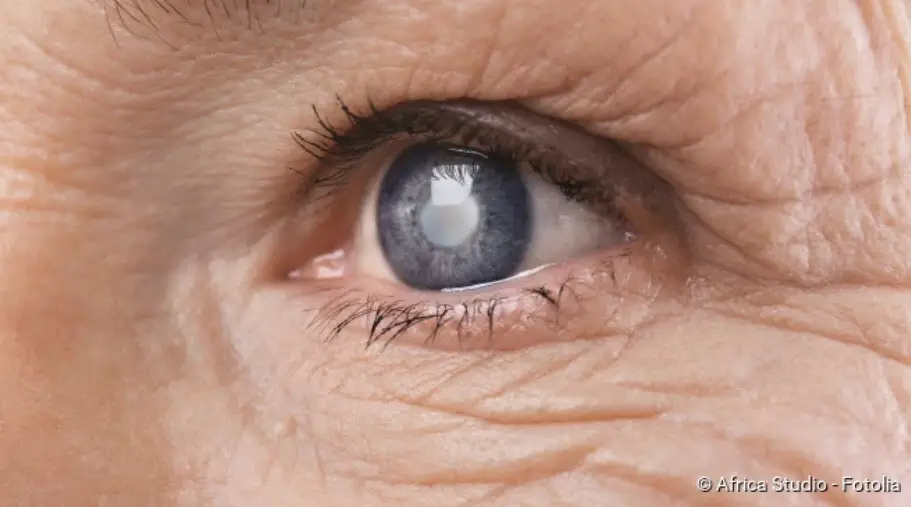Cataracts: Symptoms, Causes, Treatment
Cataracts: Symptoms, Causes, Treatment
A cataract is a very common eye disease (3) in which the otherwise clear lens of the eye becomes increasingly cloudy (2). As a result, vision steadily decreases (4). Cataracts are often age-related (1). But it can also have other triggers (5). These include, for example, metabolic diseases (7) and malformations and injuries of the eye (6). Cataracts can be well treated with an operation (10). Untreated, it can lead to blindness (8).
Read here what signs indicate cataracts, what role age plays, and why sunglasses can possibly prevent cataracts (9). The ICD codes for this condition are H28, H25, Q12, and H26.
In relation to cataract surgery, we have a complete article covering it here.

Brief overview
- Symptoms: Deterioration of vision, sensitivity to glare, vision “as if through a veil/mist
- Causes: Age, genetic factors, other diseases (e.g. diabetes mellitus), eye inflammation, injuries or malformations
- Diagnostics: including patient interview, eye test, various examinations of the eye using light (slit lamp)
- Treatment: Operation
- Prognosis: good chances of success with surgery
Symptoms Of Cataracts
If the view becomes blurred and the world seems to disappear behind a veil, this could be a sign of the eye disease cataract.
Increasing the clouding of the lens of the eye is normally common in the advanced ages of the patient. Ophthalmologists only speak of a “cataract” when the cloudy lens of the eye reduces visual acuity and the quality of vision deteriorates. Illnesses such as diabetes, an unhealthy diet, or smoking can cause the lens to cloud over more quickly. UV light also promotes cataracts – sunglasses can protect against them.
Those affected often notice that their vision is worse or that they are severely blinded when driving at night. Colors are also perceived differently. These are all vision problems that can also be caused by other eye diseases. That’s why you should see an eye doctor. Only he is the only one who can detect cataracts beyond any doubt. Older people should have their eyes checked once a year.
In general, cataracts are operated on when you have problems in everyday life or when your vision is too poor to be able to drive. But don’t worry: with over 700,000 operations a year, cataract treatment is one of the most common operations. And because the methods are constantly improving – you can also correct defective vision – most of them can be operated on sooner rather than later.
Depending on the stage, cataracts cause different symptoms. At the beginning of the disease, vision deteriorates and those affected become increasingly sensitive to glare. In the middle of the field of vision, a kind of fog is created, through which objects are perceived blurred or as if behind a veil.
Over time, this fog becomes denser and denser and spreads over the entire field of vision as the disease progresses. Colors, contrasts, and contours gradually fade and seem to merge with each other. Spatial perception and thus the ability to orientate deteriorates.
Those affected often initially ignore the symptoms, overplay them, or attribute them to other causes such as fatigue. Especially in cataracts, which develop as a result of the normal aging process, symptoms are often attributed to age-related deterioration of the eyes rather than to manifest eye disease such as cataracts.
Single and complete failures of the field of vision, as they occur in glaucoma, do not occur in cataracts.
In the further course of the disease, cataracts develop symptoms that can be very stressful for those affected in everyday life. These include:
- significant glare sensitivity (e.g. in bright sunlight or flash)
- faint visual perception
- poorer light-dark adaptation
- Effort in reading or watching television
- limited spatial vision
- Uncertainty in road traffic
These symptoms can be differently pronounced in each patient. Nor do they necessarily (all) have to occur.
Late-stage cataracts make normal everyday life almost impossible: visual performance can deteriorate so dramatically within a short time that it is tantamount to blindness.
If cataracts affect both eyes, it is often difficult for people with cataracts to assess how far the deterioration in vision has progressed. This becomes dangerous in road traffic, for example.
Relatives should watch out for signs
This is a condition where those patients affected often misjudge or deny the visual impairment. It is important that relatives know the symptoms of cataracts and interprets them correctly. In the early stages of the disease, affected people to become more insecure in their usual activities, for example driving a car or reading. This can be seen in the fact that patients often show a strained facial expression.
In later stages, the visual deterioration can become so bad that people often miss the opportunity to reach out and touch something or to take things into their own hands. They also take a long time to find their way around in an environment they are not familiar with. Therefore they often avoid foreign and unknown regions. Orientation is also becoming more difficult in the home environment. Most people with cataracts tend to meticulously keep order so that they can find everything again even without full sight.
Congenital cataract: Symptoms
Children can also suffer from cataracts. Doctors then speak of infantile or congenital cataracts. Lens opacity can already exist at birth or develop during the first years of life. The first sign is often that the children start to squint.
If left untreated, the loss of visual acuity can impair the development of the visual system, which is particularly sensitive to disorders in the first months of life. If cataracts are not detected and treated in the baby, a so-called weak-sightedness (amblyopia) can develop. This can no longer be remedied at the latest when puberty is reached. You should, therefore, see your doctor immediately if there are signs of cataracts in your child!
Causes And Risk Factors Of Cataracts
The lens of the eye is normally clear and flexible, which means that the small muscles of the eye can deform it. This deformation and the fluid surrounding the lens allow us to see near and far objects with equal sharpness (accommodation).
The eye is the most complex sensory organ. It consists of the optical apparatus, the eye nerves, and various auxiliary and protective organs.
With increasing age, the flexibility of the eye lens naturally decreases, which can result in lens opacity. Therefore, about 90 percent of all cases of cataracts are old-age cataracts. It occurs around the age of 60. According to statistics, almost half of 52 to 64-year-olds have cataracts without knowing it. This is because at the beginning of the disease there is often no perceptible visual disturbance. From the age of 65, almost everyone has a clouding of the lens of the eye.
The medical term for cataract – cataract – comes from the Greek and means “waterfall”. In the past, it was assumed that clotted fluid in the eye caused the clouding of the lens of the eye.
In addition to age-related loss of flexibility of the lens of the eye, there are other possible causes of cataracts. These include:
- Diabetes mellitus: This metabolic disease causes an increase in the sugar content of the eye fluid (and blood). Excess sugar (glucose) accumulates in the lens, which swells as a result. As a result, the arrangement of the lens fibers shifts and the lens of the eye becomes cloudy. Doctors speak of Cataracta diabetica. In pregnant women with diabetes mellitus, the child can develop cataracts in the womb of the mother.
- Other metabolic diseases: Besides diabetes, other metabolic disorders can also promote cataracts. These include calcium deficiency (hypocalcemia), hyperparathyroidism, excess ferritin in the blood (an iron storage protein), and a congenital disorder of the utilization of the sugar contained in breast milk, galactose (galactosemia).
- Eye diseases: A cataract caused by other eye diseases is called cataracta complicata. Possible triggers include inflammation of the eyes (such as inflammation of the middle eye skin = uveitis) or severe myopia. Cataract caused by other eye diseases is called cataracta complicata.
- Eye injury: A contusion of the eyeball from a fist punch or tennis ball, stab wounds or deeply penetrated foreign bodies can also cause cataracts. Doctors then speak of Cataracta traumatica.
- Congenital eye deformities: If cataracts are congenital, this can have two reasons: One is a genetic defect that leads to a malformation of the eye and thus to clouding of the lens of the eye. This applies to about 25 percent of all congenital cataract diseases. On the other hand, certain infectious diseases during pregnancy (rubella, toxoplasmosis, herpes) can cause the child to be born with cataracts. This congenital cataract is called Cataracta congenita.
- Other causes: Lens metabolism defects, malnutrition, heavy smoking, radioactive radiation and ultraviolet light (UV light) can also trigger cataracts. Very rarely, medication or poisoning is the reason for lens of the eye opacity.
Diagnosis Of Cataracts
For the diagnosis of cataracts, a detailed examination by the ophthalmologist is necessary. The first step is a detailed discussion between doctor and patient to take the patient’s medical history (anamnesis): During this discussion, the doctor inquires, among other things, about the exact symptoms as well as any existing underlying diseases (diabetes, eye diseases, etc.).
The visual function is then checked. This is sometimes done by first dilating the pupil with special eye drops. The following examinations help in the diagnosis of cataracts:
- Brückner test: In this examination, the doctor x-rays the eye. Since the retina reflects part of the light, the lens of the eye opacities are visible as dark spots.
- Examination at the slit lamp microscope: The slit lamp is a microscope for magnifying the eye with a light source that can be swiveled to both sides. The bundled, slit-shaped beam of light shines through the transparent areas around the eyes. This also allows the doctor to examine the retina at the back of the eye and see what type of cataract is present and what could be the cause.
- Corneal exams: In addition, the doctor can measure the thickness of the cornea (pachymetry) or image its surface and back surface using computer-assisted methods (Pentacam). In this way, it can be determined whether the cornea is evenly curved (otherwise it may have to be surgically corrected with special lenses). In addition, it is checked whether the cell layer which supplies the cornea and ensures its transparency is in order (determination of the endothelial cell density).
- General eye test: Routinely, the ophthalmologist will also check general vision, for example by means of vision charts, and whether other eye diseases are present.
If cataracts are already well advanced, the clouding of the lens can already be seen with the naked eye.
Other investigations: Sometimes cataracts are the first sign of another underlying disease. Additional examinations, such as skin and muscle tests and blood tests, are therefore necessary, especially for young patients. For example, tetany (pathological muscle cramps), myotonia (muscle disease), skin diseases, Wilson’s disease (congenital disorder of copper metabolism), or diabetes mellitus can be diagnosed.
Treatment Of Cataracts
Cataracts can only be effectively treated by surgery. The cloudy lens of the eye is (partially) removed and replaced by an artificial lens. The procedure can usually be performed on an outpatient basis in the doctor’s surgery. When surgery is performed depends on various factors, such as how much the clouding of the lens affects everyday life.
The risks of the intervention are comparatively low. Complications are rare. However, patients should avoid physical exertion and activities that generate a lot of dust or dirt in the first period thereafter. Furthermore, the freshly operated eye must not come into contact with soap and water.
You can read everything important about surgical cataract treatment in the article Cataract surgery.
Prognosis Of Cataracts
If left untreated, cataracts progress slowly but steadily – the vision becomes worse and worse until the affected person goes blind on the diseased eye. This can only be stopped with an operation: An age cataract can usually be completely cured by the procedure – most patients regain 50 to 100 percent of their visual acuity.
If the cataract is caused by another eye disease (such as glaucoma or macular degeneration), the prognosis is less good. The same applies if cataracts are caused by a general disease such as diabetes.
Prevention
Age-related cataracts (age-related cataract) can be prevented so far, neither by medication nor by other measures such as eye exercises.
On the other hand, external factors that can trigger cataracts can be controlled and eliminated. For example, you should always wear protective goggles during activities such as grinding or drilling where the eye could be injured. When staying in the sun (especially when skiing), good sunglasses protect your eyes from the dangerous UV radiation. You should also wear protective glasses in the solarium.
In addition, from the age of 40 onwards, go to an ophthalmologist every 12 to 24 months to have your vision checked. By means of a regular eye test, cataracts can already be detected when the symptoms are still hardly pronounced.
If you wish to become pregnant, you should also have your vaccination checked and refreshed if necessary. This helps to prevent infections that can cause cataracts in babies.





